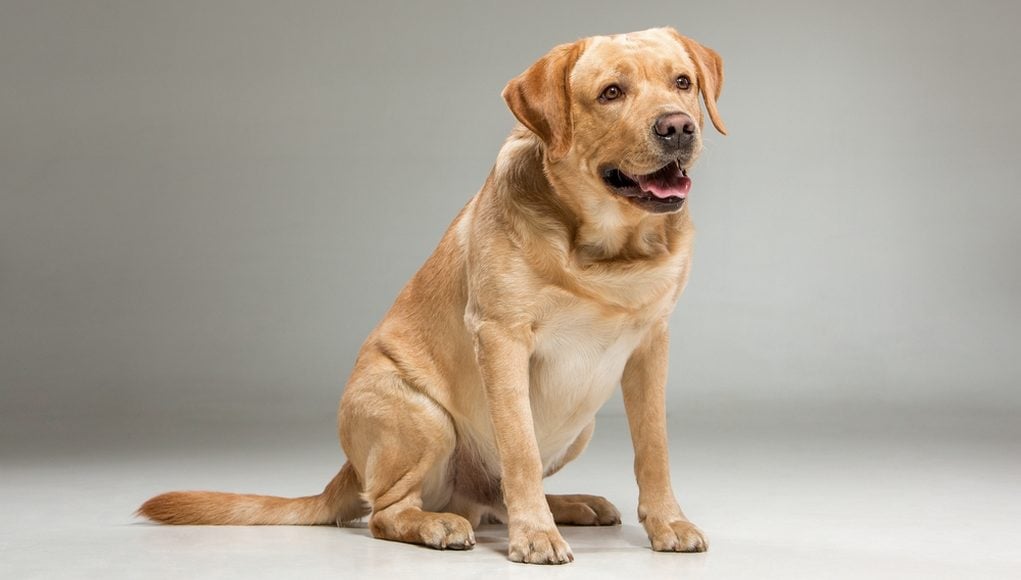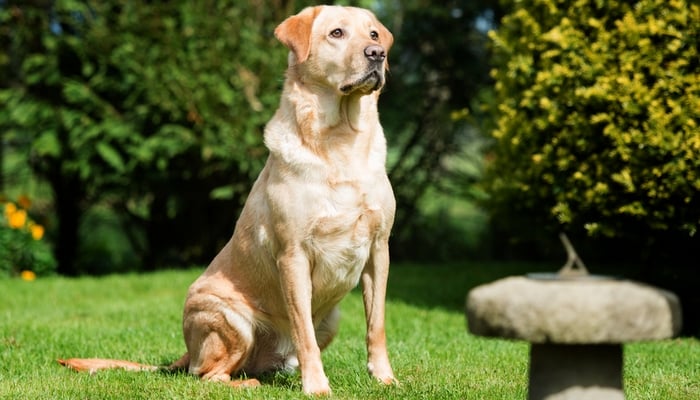The Goldador is the clearest proof that you can rarely go wrong when you mix something great with something awesome – the end result is very likely to impress. A cross between Golden Retrievers and Labrador Retrievers, the Goldador Dog Breed is a mixed breed that encompasses all the great qualities of its originators.
Goldadors are both highly intelligent and obedient, which makes them one of the easiest dog breeds to train. They are also exceptionally good-willed and loving, which makes them exceptional family members. They are great with kids and other pets, and they are even very good professional dogs, be it as guide dogs or service dogs.
Well, while Labrador Retrievers and Golden Retrievers are two distinguishably different breeds, you will be forgiven if you find it a bit harder to distinguish Goldadors from Labrador Retrievers. They have the same short double coat as Labradors, and while their coloring usually ranges from yellow to reddish gold, they can often times have a black coat as well.
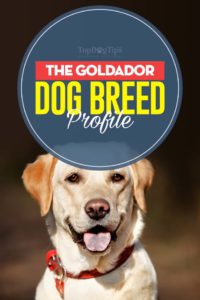 Additionally, since a lot of owners mix up Labrador Retrievers, Golden Retrievers and Goldadors by themselves, there really isn’t much of a standard on how exactly the breed should be in terms of its physical appearance. Even more so, to this day there are still no official breed clubs for Goldadors. Regardless, since the Goldador’s two originating breeds are still very much with us, it is an official breed in and of itself.
Additionally, since a lot of owners mix up Labrador Retrievers, Golden Retrievers and Goldadors by themselves, there really isn’t much of a standard on how exactly the breed should be in terms of its physical appearance. Even more so, to this day there are still no official breed clubs for Goldadors. Regardless, since the Goldador’s two originating breeds are still very much with us, it is an official breed in and of itself.
If you're thinking that the Goldador dog breed must extremely intelligent, because both originating breeds are very intelligent, you'd be correct! The intention behind the Goldador was for them to have the loving sensibility of Golden Retrievers, as well as the tolerance of Labrador Retrievers. And they do, which makes them excellent not only as family dogs but also as guide and service dogs, bomb squad dogs, search and rescue dogs and therapy dogs.
All that being said, Golden Retrievers and Labrador Retrievers are definitely not “bad” either. Both breeds excel at the above professions as well, which is why they were mixed in the first place. So, while it’s really hard to put the label “better” anywhere, all three breeds are constantly winning different competitions and topping charts. The Goldador dog breed is definitely up to par with its originators in every regard.
Goldador Dog Breed Profile
Physical Characteristics and Personality
The Goldador is no small dog. With a height of 22 to 24 inches and a weight of 60 to 80 pounds, the Goldador is best suited for a country house with a big, fenced yard. These dogs are physically strong and active, so they require not just two short walks every day but at least 30+ minutes of full-on running without a leash in addition to two prolonged walks.
All that being said, the Goldador is an indoors dog. It can’t stand to be alone, so it should never be left outside by itself, and as an indoors dog it can very well live in an apartment without a yard. However, if that is the case, a responsible owner should still give the dog the exercise it needs.
These dogs are easy to train, as they are extremely intelligent. A typical Goldador will be happy to play practically anything with you, as long as it’s actually able to do it. Goldadors love fetch & retrieve games (that’s the essence of all Retriever breeds) – discs, balls, anything you can throw will be exciting for them. They enjoy hiking with their owner, and they are also eager and excellent swimmers.
Goldadors love mental games as well. As a particularly intelligent breed, you can give them puzzles and they’ll enjoy solving them, as long as you also make it interesting for them by adding some verbal praise, petting and a treat.
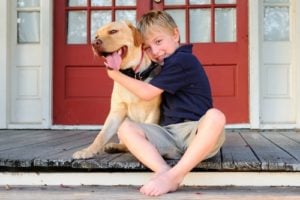 We’d honestly be struggling to find anything negative about the Goldadors personality. If we really try, the only “negative” characteristic would be things that aren’t intended for a Retriever dog anyway. For example, we can say that the Goldador, like any other Retriever, is a really bad guard dog. It’s simply too nice to get the job done. It’s an excellent watch dog, though, as it will inform you every time it sees someone new.
We’d honestly be struggling to find anything negative about the Goldadors personality. If we really try, the only “negative” characteristic would be things that aren’t intended for a Retriever dog anyway. For example, we can say that the Goldador, like any other Retriever, is a really bad guard dog. It’s simply too nice to get the job done. It’s an excellent watch dog, though, as it will inform you every time it sees someone new.
Most dog breeds don’t do too well alone, but the more social a dog is, the more it needs the human presence. If you’re living alone and you spend too much time at work or outside in general, the Goldador dog breed will simply suffer home alone.
Not to mention that if you don’t train it properly, your home might suffer a bit as well. When they're young, these dogs love to chew and rough house. So, unless you can give your dog the attention it requires, it’s probably not recommended to get one of the most social animals on the planet for a pet, including the Goldador.
Goldadors, just like Golden Retrievers and Labrador Retrievers, are one of the best family breeds out there. Very social, fun, intelligent, playful and gentle, a well-trained Goldador is sure to give all family members a ton of happy memories.
As far as toddlers and small children go, you’d do well to both instruct them and teach them how to play with the dog, and supervise them until they are older. The Goldador itself will love your kids, but if they tend to irritate it too much – pull its tail, ears, and fur, bother it when it’s tired and is trying to sleep, bother it when it’s eating – you can understand why the dog won’t react well. Generally speaking, if your kids are too small to know better, pay close attention to them.
RELATED: Labrador Retriever Dog Breed Profile
History of the Goldador Dog Breed
Referring to the Goldador as “a fairly recent breed” is an understatement. Goldadors are such a recent breed that there’s practically nothing we can say about their history. Frankly, it hasn’t happened yet! As of 2017, we’re still within the second decade of their inception.
Golden Retrievers and Labrador Retrievers are not particularly old breeds either. Both were developed in the first half of the 20th century. The Labrador originated in Canada, where it was bred as a Retriever dog for fishermen, intended to help them getting their fish and fishing lines. Later on, it got popular in Britain and from there – back across the Atlantic, to the U.S.
Golden Retrievers were created around the same time in Scotland to retrieve waterfowl and other birds. They quickly became popular across the entire British Isles, and they also crossed the ocean to the U.S. where they are currently the second most popular dog breed.
Care and Training of Goldadors
With the Goldador dog breed, much like with other dog breeds, there is a laundry list of things that you need to do to care for them. From training to grooming and everything in between, it's important to be prepared for all the responsibilities that are coming your way.
When looking for a Goldador, look at the dog's mother, and if possible, at his father and other siblings as well. The personality of the dog is most likely going to match that of its parents. The rule of thumb here is that when you are picking a puppy from a litter, it’s recommended to choose a mild-tempered puppy.
Don’t go for the biggest one, the dog that bullies all its siblings, but don’t choose the shiest one either. Which parent is a Golden Retriever and which is a Labrador Retriever? Honestly, these distinctions won’t matter much, as long as you like the parents’ personalities.
Any form of negative reinforcement, be it verbal or physical abuse, will make the dog lose trust in you, become less obedient, and overall depressed.
Training is vital for a Goldador. All Retriever dogs like to bark and act like watchdogs, so you’ll need to teach it not to, especially if you don’t want your neighbors (or the infamous mailman) to suffer. Training for Goldadors, just like it is for other breeds, is best done through positive reinforcement. Praises, petting, play and treats will get you a long way with these dogs.
Mental exercises are also very important for the Goldador dog breed. They are not just something that the Goldador can do, they are something that it should do.
If you don’t give your Goldador enough mental challenges, you might as well not bother getting one of the smartest dogs on the planet for a pet. Without the proper intellectual practice, the Goldador will grow into a passive, uninspired and humorless dog. Your dog may also become bored if he's not mentally stimulated, and that could lead to behavior issues like nuisance barking and chewing.
All dogs need to be well socialized, and that’s true both for the more social breeds and for the more antisocial ones. If you don’t regularly socialize your Goldador, it will grow into a timid, socially awkward dog that gets nervous around strangers.
Frequent socialization is also the easiest way to teach your Goldador not to bark. If your dog learns early on that strangers are nothing to worry about, he will simply stop barking at them. Of course, if he barks out of aggression, you've got another problem on your hands that should be addressed with a professional dog trainer.
Taking care for the coat of the Goldador is also vital, as it is for all breeds. The Goldador has the short, thick double coat of the Labrador Retriever, and they shed a bit as well. For that reason, weekly brushing is needed to take care of the dead hair, because it will otherwise make the dog’s coat a burden both for the animal and for your home.
Especially during seasonal shedding periods, you’ll want to brush your Goldador practically on a daily basis.
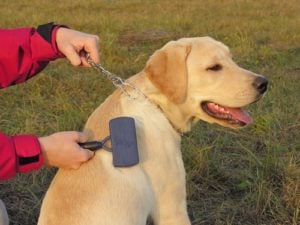 Baths are also needed quite often, depending on how much time your dog spends outside and what he does while out there. As far as the dog's other features, care for them is similar to that of all dogs. You can check out our article on the subject for more information on the right grooming schedule for your dog.
Baths are also needed quite often, depending on how much time your dog spends outside and what he does while out there. As far as the dog's other features, care for them is similar to that of all dogs. You can check out our article on the subject for more information on the right grooming schedule for your dog.
The ears should be regularly cleaned up. Dogs’ ears, unlike ours, can trap water, dirt and all sorts of other things, which can lead to infections. Brush your dog’s teeth 2-3 times per week as well. If you are up to it, it’s recommended to even do it daily.
Trim your dog’s nails once or twice per month if need be. Some dogs will wear their nails out themselves, especially when given enough time and exercise outside. But, if you can hear your dog’s nails clicking on the floor – it’s time for a trimming.
You can check out our video guides on dog grooming for more detailed information about these common grooming tasks and a simple demonstration of how to perform them without hurting your dog:
- How To Bathe A Dog 101 – A Step-by-Step Video Guide
- How To Clean Dog's Ears 101 – A Step-by-Step Video Guide
- How To Cut Dog's Nails 101 – A Step-by-Step Video Guide
Feeding a proper diet is one of the biggest parts of caring for a Goldador dog breed. Puppies, seniors and dogs with health conditions will all need to eat a diet that caters to their unique nutritional needs. It's best to consult your vet or a canine nutritionist about the best food for dogs in these categories.
You should feed your adult dog with 3.5 to 4.25 cups of high-quality dry dog food, spread over two meals. Don’t just give it all the food at once. Establish a healthy eating habit of twice per day.
As far as the exact quantity goes, that depends on the dog’s size, gender, age, and exercise level. As long as you don’t make your pet obese (and Goldadors get obese quite easily if you overfeed them and don’t give them enough exercise) and don’t keep him hungry, your dog will be happy.
RECOMMENDED: Golden Retriever Breed Profile
Common Health Concerns the Goldador Dog Breed
Goldadors, just like Golden Retrievers and Labrador Retrievers, are hardly among the dog breeds that have become infamous for their health issues. However, they are still living animals, and as such are prone to a set of diseases and conditions. None of these are guaranteed to happen to your dog, but it’s best to look out for them if you want Fido to be healthy and happy.
Here’s a quick list of some of the most common health concerns seen in the Goldador dog breed:
Hip Dysplasia – This is a heritable condition where the thighbone doesn’t fit properly into the hip joint. It can cause pain, but it can also remain unnoticed for a long time. It often leads to arthritis. X-rays can easily find this problem. Dogs with hip dysplasia are not supposed to be bred, so always make sure to ask the breeder for proof of the dog’s parents’ health.
Elbow Dysplasia – This is a heritable condition as well. With Elbow Dysplasia, the three bones of the dog’s elbow grow with different speed and at different proportions.
Diabetes – Just like with humans, diabetes is caused when the body can’t regulate the blood sugar level. It’s treated with a proper diet and daily insulin injections.
Progressive Retinal Atrophy (PRA) – PRA is a family eye disease that involves the deterioration of the retina.
Cataracts – This is a sight difficulty caused by an opacity on the eye lens. Simply put, this condition causes cloudy eyes. It usually happens in the dog’s old age. It can sometimes be surgically treated.
It’s important to talk to a responsible dog breeder before purchasing your future companion. For example, you can consult with the Pet Professional Guild on how to find a trustworthy pet breeder. An adequate professional dog breeder will provide you with health clearances for both parents of the puppy and prove that it’s been tested and cleared of many of the possible conditions it might have.
With Goldadors, you should look for health clearances from Auburn University for Thrombopathia; from the Orthopedic Foundation for Animals (OFA); as well as from the Canine Eye Registry Foundation (CERF) to make sure that the puppy’s eyes are well.
READ NEXT: 30 Best Hunting Dogs for All Types of Game and Hunts


